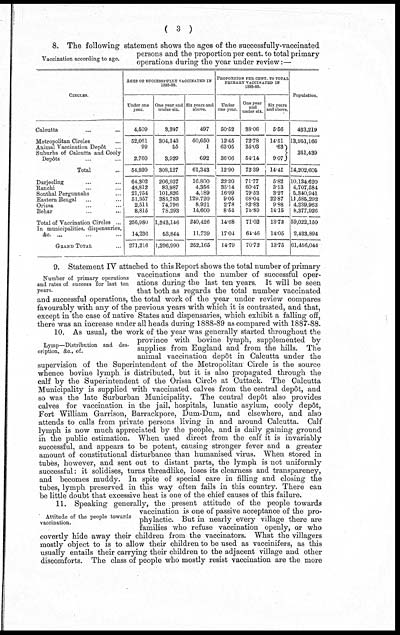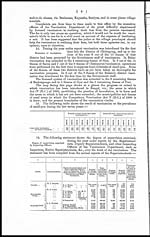Medicine - Vaccination > 1874-1889 - Report on vaccination in the Province of Bengal > Annual statistical returns and brief notes on vaccination in Bengal for the year 1888-89
(525) Page 3
Download files
Individual page:
Thumbnail gallery: Grid view | List view

( 3 )
Vaccination according to age.
8. The following statement shows the ages of the successfully-vaccinated
persons and the proportion per cent. to total primary
operations during the year under review:—
|
CIRCLES. |
AGES OF SUCCESSFULLY VACCINATED IN |
PROPORTION PER CENT. TO TOTAL |
Population. |
||||
|
Under one |
One year and |
Six years and |
Under |
One year |
Six years |
||
|
Calcutta ... ... |
4,509 |
3,397 |
497 |
50.52 |
38.06 |
5.56 |
433,219 |
|
Metropolitan Circles ... |
52,061 |
304,143 |
60,650 |
12.45 |
72.78 |
14.51 |
13,951,166 |
|
Animal Vaccination Depôt ... |
99 |
55 |
1 |
63.05 |
35.03 |
.63 |
251,439 |
|
Suburbs of Calcutta and Cooly |
2,760 |
3,929 |
692 |
36.06 |
54.14 |
9.07 |
|
|
Total ... |
54,920 |
308,127 |
61,343 |
12.90 |
72.39 |
14.41 |
14,202,605 |
|
Darjeeling ... ... |
64,302 |
206,937 |
16,800 |
22.30 |
71.77 |
5.82 |
10,134,620 |
|
Ranchi ... ... |
48,812 |
83,987 |
4,356 |
35.14 |
60.47 |
3.13 |
4,707,584 |
|
Sonthal Pergunnahs ... ... |
21,754 |
101,826 |
4,189 |
16.99 |
79.53 |
3.27 |
5,340,941 |
|
Eastern Bengal ... ... |
51,357 |
385,783 |
129,720 |
9.05 |
68.04 |
22.87 |
11,585,292 |
|
Orissa ... ... |
2,511 |
74,796 |
8,921 |
2.78 |
82.83 |
9.98 |
4,239,963 |
|
Behar ... ... |
8,815 |
78,293 |
14,600 |
8.54 |
75.89 |
14.15 |
8,377,926 |
|
Total of Vaccination Circles ... |
256,980 |
1,243,146 |
240,426 |
14.68 |
71.02 |
13.73 |
59,022,150 |
|
In municipalities, dispensaries, |
14,236 |
53,844 |
11,739 |
17.04 |
64.46 |
14.05 |
2,433,894 |
|
GRAND TOTAL ... |
271,216 |
1,296,990 |
252,165 |
14.79 |
70.72 |
13.75 |
61,456,044 |
Number of primary operations
and rates of success for last ten
years.
9. Statement IV attached to this Report shows the total number of primary
vaccinations and the number of successful oper-
ations during the last ten years. It will be seen
that both as regards the total number vaccinated
and successful operations, the total work of the year under review compares
favourably with any of the previous years with which it is contrasted, and that,
except in the case of native States and dispensaries, which exhibit a falling off,
there was an increase under all heads during 1888-89 as compared with 1887-88.
Lymp—Distribution and des-
cription, &c., of.
10. As usual, the work of the year was generally started throughout the
province with bovine lymph, supplemented by
supplies from England and from the hills. The
animal vaccination depôt in Calcutta under the
supervision of the Superintendent of the Metropolitan Circle is the source
whence bovine lymph is distributed, but it is also propagated through the
calf by the Superintendent of the Orissa Circle at Cuttack. The Calcutta
Municipality is supplied with vaccinated calves from the central depôt, and
so was the late Surburban Municipality. The central depôt also provides
calves for vaccination in the jail, hospitals, lunatic asylum, cooly depôt ,
Fort William Garrison, Barrackpore, Dum-Dum, and elsewhere, and also
attends to calls from private persons living in and around Calcutta. Calf
lymph is now much appreciated by the people, and is daily gaining ground
in the public estimation. When used direct from the calf it is invariably
successful, and appears to be potent, causing stronger fever and a greater
amount of constitutional disturbance than humanised virus. When stored in
tubes, however, and sent out to distant parts, the lymph is not uniformly
successful: it solidises, turns threadlike, loses its clearness and transparency,
and becomes muddy. In spite of special care in filling and closing the
tubes, lymph preserved in this way often fails in this country. There can
be little doubt that excessive heat is one of the chief causes of this failure.
Attitude of the people towards
vaccination.
11. Speaking generally, the present attitude of the people towards
vaccination is one of passive acceptance of the pro-
phylactic. But in nearly every village there are
families who refuse vaccination openly, or who
covertly hide away their children from the vaccinators. What the villagers
mostly object to is to allow their children to be used as vaccinifers, as this
usually entails their carrying their children to the adjacent village and other
discomforts. The class of people who mostly resist vaccination are the more
Set display mode to: Large image | Zoom image | Transcription
Images and transcriptions on this page, including medium image downloads, may be used under the Creative Commons Attribution 4.0 International Licence unless otherwise stated. ![]()
| Permanent URL | https://digital.nls.uk/91537755 |
|---|
| Additional NLS resources: | |
|---|---|




